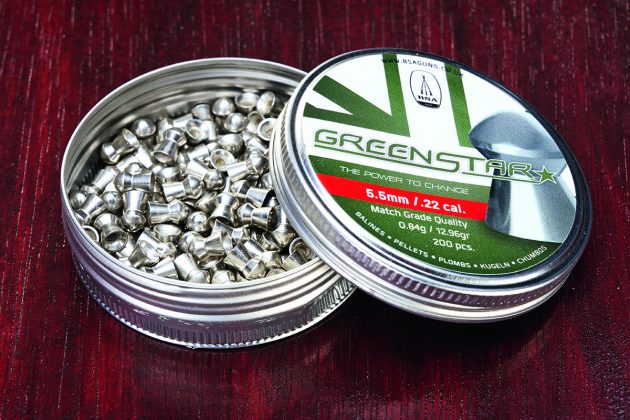Mike Morton prepares for one possible version of the future and tests the environmentally friendly Green Star pellets from BSA
BSA Green Star .22 review
As many of you will already be aware, the Health and Safety Executive published the UK REACH dossier which proposes restrictions on the use of lead ammunition, including airgun pellets. These proposed restrictions remain just that for now, but it doesn’t hurt to prepare for a future that could see the use of lead pellets being severely curtailed. Some forward-thinking manufacturers already offer lead-free alternatives, including BSA with its new Green Star ammo.
Green Star pellets are available in both .177 and .22, and it’s the larger size I’ll be testing here. Lead remains the preferred material for making pellets because their mass and density make them ballistically superior, especially when shot at the relatively low muzzle velocity of the sub-12 foot pound air rifles that most of us use here in the UK. Nevertheless, Green Stars are a viable alternative, with BSA describing them as match-grade.
As always, my testing began with a visual inspection and a weigh-in. Green Stars are made of an incredibly hard, crush-resistant alloy, which is also incredibly shiny. While some modern domehead diabolo pellets have a squashed head, these pellets have a definite dome shape.
They’re supplied in a tin of 200 in .22 calibre. They have a recommended retail price of £16.50, working out at 8.25p per pellet. This is of course higher than a similar lead pellet, but is very much in line with other lead-free examples in this calibre.
What you get for this expenditure is a tin of pellets that are utterly pristine in terms of cleanliness and lack of damage or deformation.
With the high quality pellets that are available these days I’m used to seeing a lack of swarf, oil or any other manufacturing process debris, but BSA Green Stars take cleanliness to the next level.
Having put my standard trial sample of 50 random pellets over the scales, I found their consistency to be very good, with 45 weighing 13.2 grains and five weighing 13.4 grains, giving an average measured weight of 13.22 grains compared with a stated weight of 12.96 grains, the usual caveat being that my scales may not be perfectly calibrated, but are at least consistent.
Key specs

Pellet: Green Star
Supplied by: BSA Guns (bsaguns.co.uk)
Type: Lead-free domehead diabolo
Calibre: .22
Head size: 5.50mm
Supplied in: Tin of 200
Price: £16.50
Price per pellet: 8.25p
Advertised weight: 12.96 grains
Measured weight: 13.22 grains
Pellet length: 8.41mm
Suggested uses: Close-range hunting, target shooting and plinking
Test Conditions
This shoot was conducted on a hot, bright day, with a gentle breeze. All shots were taken at 1” Birchwood Casey Target Spots.
I tried shooting these pellets with my BSA R-10 SE and Weihrauch HW100 S before settling on the R-10. I’d previously found lead-free pellets to prefer a coating of pellet lube, and so experimented with this, but found it actually impaired accuracy in both rifles, so the following results all come from “dry” pellets.

These pellets were consistent in muzzle velocity and also weight, with 45 weighing 13.2 grains and five coming in at 13.4

Green Stars have a distinctive head shape and a fairly long skirt, and as expected from a lead-free pellet, are made from a very tough alloy
Downrange
With the barrel cleaned of any remaining fouling, I zeroed the R-10 at 30 yards and proceeded to put 10 shots over the chronograph. I found these 13.22 grain pellets were being spat out of the barrel with an average muzzle velocity of 613.7 feet per second, with the rifle delivering a muzzle energy of 11.06 foot pounds.
The all-important variation in velocity was 8.8 feet per second, with one shot notably faster than the rest. With this taken out of the mix, variation dropped to a mere 5.3 feet per second. I rate any variation under 10 feet per second as good, with anything around five being excellent.
While carrying out both my preliminary zeroing and chrono testing I did notice accuracy to be poor at 30 yards, so I decided to reduce the three target distances to 15, 20 and 25 yards. As the weight and velocity figures show, these pellets are very well made indeed, but 30 yards proved just too far, with an erratic spread from both rifles.

Modern manufacturing techniques mean most quality lead pellets are clean out of the tin, but the Green Stars take it up a notch
However, with the rifle now re-zeroed at 20 yards, it was a different story.
At 15 yards, the size of my five-shot group was a tiny 3.5mm centre-to-centre, with me applying 6mm of holdover. Back at 20 yards, and with my aiming on, my
five-shot group size expanded a little to 9.3mm.
And at 25 yards it was a thoroughly competent 10.6mm centre-to-centre, this time with me applying 16mm of holdover.
The study of ballistics always amazes me, and while I don’t truly understand why the accuracy should drop off so suddenly, 30 yards was just too big of an ask for my specific combo. But at my reduced distances, these results were stunning.
Verdict
Cut back on the distance you shoot at, and BSA Green Star pellets in .22 calibre offer a stunning level of accuracy for pretty much any job you’d care to ask of them




